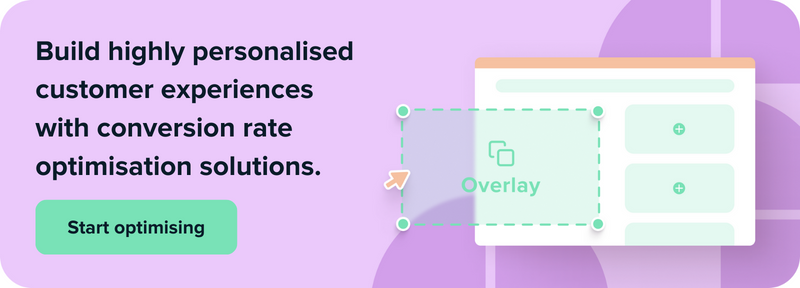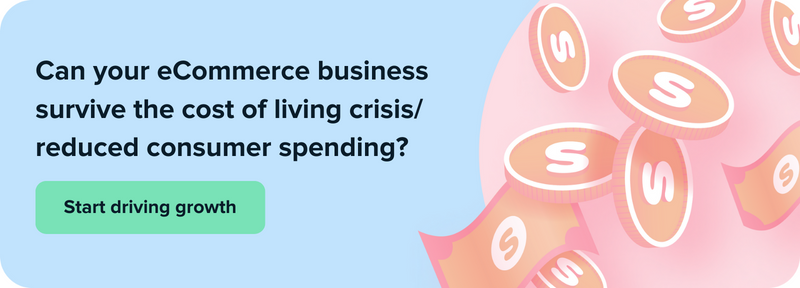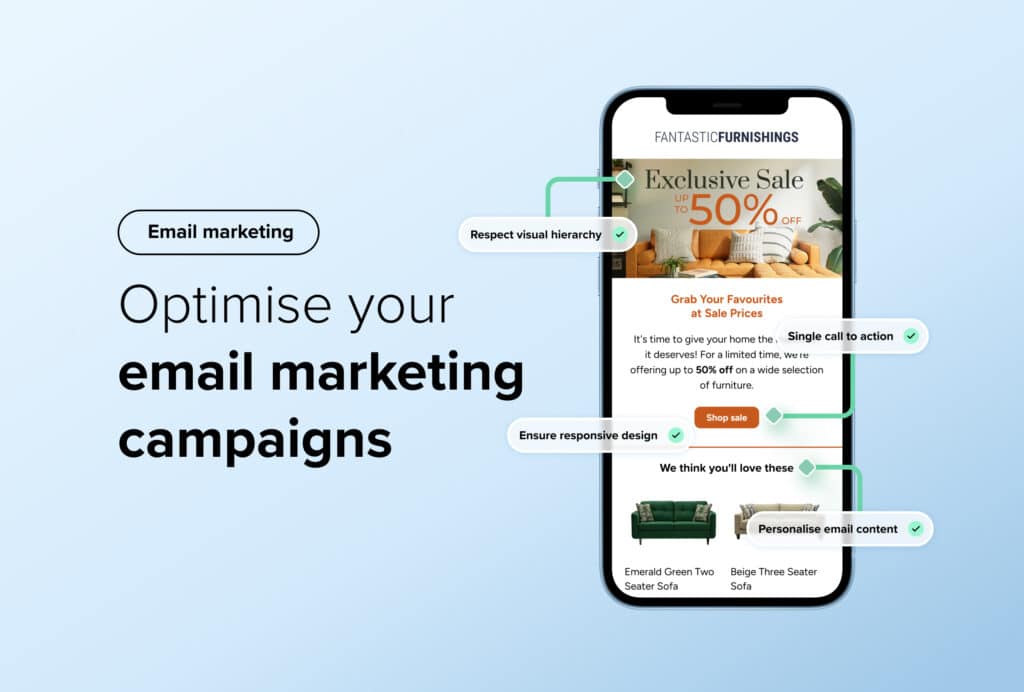How to Get Website Personalisation Right: The Dos and Don’ts
By Bethany Llewellyn • Last updated: Monday Jun 17th, 2024

With 77% of customers stating they prefer to shop with brands that provide a personalised experience, it’s important that eCommerce retailers know what they should and shouldn’t do when it comes to personalisation.
Below, we identify the importance of a website personalisation strategy along with various personalisation ideas to help you identify the dos and don’ts of personalisation.
What is website personalisation?
Personalising the on-site shopping experience means utilising data insights and customer behaviour to display items a customer likes and wants; making the overall shopping experience more convenient for the customer and resulting in more conversions for the business.
It’s not one size fits all, website personalisation can be optimised for each visitor based on various audience conditions, such as user behaviour, the type of page a user lands on or even the user’s device type.
A tailored customer journey means dynamic touchpoints, giving brands the opportunity to provide seamless, relevant experiences whether online, opening an email or launching a mobile app.
Now more than ever consumers expect a personalised experience when shopping online, and it’s something that more and more businesses are implementing.
In fact, 87% of consumers stated a personalised experience positively influences how they feel about a brand and 91% of consumers are more likely to shop with brands that provide relevant offers and recommendations.
It’s vital that eCommerce businesses listen to their customers, understand them and pay attention to their specific wants and needs.
Ultimately, no two customers who visit your site are the same, so why would you provide the same experience for both?
Related: Discover the next step in website personalisation.
Personalisation done right
1. Grab the user’s attention with relevant content
Personalisation doesn’t have to start and end with your eCommerce site.
Use ads across all platforms, including social media and search engines, to show your potential customers your product offerings based on their searches or clicks.
This helps with brand awareness and allows you to identify your target audiences based on the users who visit your site via these ads.
From here, you can provide relevant content and direct users through the search and discovery process to secure purchases.
However, the keyword is relevant content. You have spent time and resources attracting new audiences to your site, so don’t deter them at this stage.
Make sure you use the information the shoppers give you, from their previous shopping behaviours to their recent searches, to provide a tailored on-site experience.
Related: Using personalisation to reduce bounce rates.
2. Utilise AI-powered personalisation tools
AI can help you deliver an optimised customer experience by using data to automate recommendations, allowing you to make better business decisions and future predictions.
Introducing AI-powered tools on your eCommerce site comes with various benefits, such as improved search and discovery capabilities, increased average order value and provides a streamlined customer experience.
Most of all, consumers support this, with 62% of consumers willing to submit data to AI to have better experiences with businesses.
By using artificial intelligence, you can predict what customers want before they know it themselves, similar to how shoppers rely on salespeople in brick-and-mortar stores.
This allows you to guide shoppers through the sales funnel to complete a purchase quicker with minimal effort.
Related: How artificial intelligence can transform the customer journey.
3. Personalise based on your industry or product catalogue
Personalisation strategies on your eCommerce site allow you to provide a completely tailored experience to every customer that visits your store.
Take it a step further to replicate in-store experiences and provide a similar experience both in-store and online.
For example, if you are a high-end or luxury jewellery retailer, the in-store experience would include a streamlined experience or even a 1-1 sales assistant.
Taking this online, you would avoid certain marketing strategies depending on the industry you’re in or the products you offer.
Countdown timers or free delivery threshold reminders may not work for those with a higher-ticket item but would work perfectly for those with a lower basket value.
Ultimately, tailoring your personalisation strategies based on your product offering means every journey is unique to your customer.

4. Use segmentation to personalise each customer’s journey
Customer segmentation involves grouping a company’s target audience into categories with similar characteristics, such as age, location or time spent on specific product pages.
By segmenting customers, you will be able to make decisions based on each segment in order to maximise the value of each customer to your business.
Both new and returning customers will require different approaches, so analysing demographic information will ensure you deliver the right message at the right time, to the right customer.
This can be achieved on-site with tools such as Salesfire’s Digital Assistant, which can display and store CRO campaigns such as newsletter collection, product views or reserved stock countdown.
Or, off-site through email marketing to retarget customers with abandoned orders, or product suggestions based on their browsing behaviour.
Related: Personalise the customer journey with targeted messaging.
Don’t make these mistakes
1. Neglecting your data
Now more than ever, vast amounts of data are available at our fingertips.
Consumers can find thousands of eCommerce sites in just a few clicks, along with information on almost every aspect of online shopping.
This isn’t just a play for consumers, this information is readily available for eCommerce retailers to analyse and improve their own marketing strategies.
Due to the transparency of online shopping, you should use this data to your advantage to help you personalise your site to drive revenue.
As an eCommerce retailer, one of the first things you should do is determine goals or set KPIs. From here, you can identify the data that will help you achieve your targets and address them.
For example, if you want to reduce your basket abandonment rate, you should take a look at where customers are dropping off.
Whether it be a lengthy checkout process or slow load times, this data will allow you to react and adjust your eCommerce strategy accordingly.
2. Is there such a thing as too much?
With your CRO and personalisation tools, you may want to try out every feature or functionality to ensure you get your money’s worth – but this isn’t always the right approach.
While the possibilities of personalisation are endless, your time and resources are not.
The first thing you can do is start small, and build your strategy accordingly. This will allow you to identify what works, or what could be improved.
Whether you’re a smaller retailer or large, you can ensure you don’t overwhelm your business and achieve goals by creating a baseline of personalisation on your eCommerce site, slowly building as time goes on.
Alternatively, using platforms which go hand in hand can ensure you have all of your data and strategies in one place, like Salesfire’s suite of AI-powered personalisation tools that works effortlessly together to provide a seamless experience for your consumers.
This streamlined website personalisation software allows you to focus on your marketing efforts with the security of conversions.
3. Don’t interrupt the shopping experience
Your personalisation strategies should be helpful, not distracting.
It shouldn’t interfere with the customer’s on-site journey and it definitely shouldn’t deter a purchase.
Instead of interruption, personalised marketing is about delivering value at just the right time that a customer needs it.
This can hugely impact customer satisfaction for the better and drive repeat business and improve brand reputation.
Using subtle messaging that conveys key information and provides product inspiration is the key to providing a seamless shopping experience and increasing customer retention.
Knowing your customer’s wants and needs gives you a competitive advantage, allowing for effortless product discovery and increasing revenue.
4. Don’t be too restrictive with personalisation
As an eCommerce retailer, it’s great to guide customers through the on-site journey and lead them right through to a purchase.
This is one way to secure a conversion, but it doesn’t quite work for every customer.
In order to maximise your conversions and ensure you provide a great customer experience, you need to allow room for product discovery and product inspiration.
Think of it this way, a user’s past purchases may have been a gift for others and not an item themselves, so they’re not necessarily going to want recommendations similar to this product in future visits.
Using a mixture of AI-powered algorithms in your CRO tools can help with this, by suggesting genuinely relevant products your customers will love – from new in and best sellers to bought together and visually similar.
Varying up the recommendations you serve is a great way to ensure your customers feel valued.
Related: Utilise personalised search and discovery experiences to increase AOV.
Final thoughts
Although there isn’t a wrong way to use personalisation on your eCommerce site, by now you will appreciate the difference between the most effective personalisation strategies.
Consumers expect a personalised experience as standard when online shopping, so if you haven’t already, now is the time to review how you utilise personalisation on your eCommerce site.

See how Salesfire can help you optimise your product discovery experience, email one of our experts at enquiries@salesfire.com or book a free demo of our personalisation tools.



